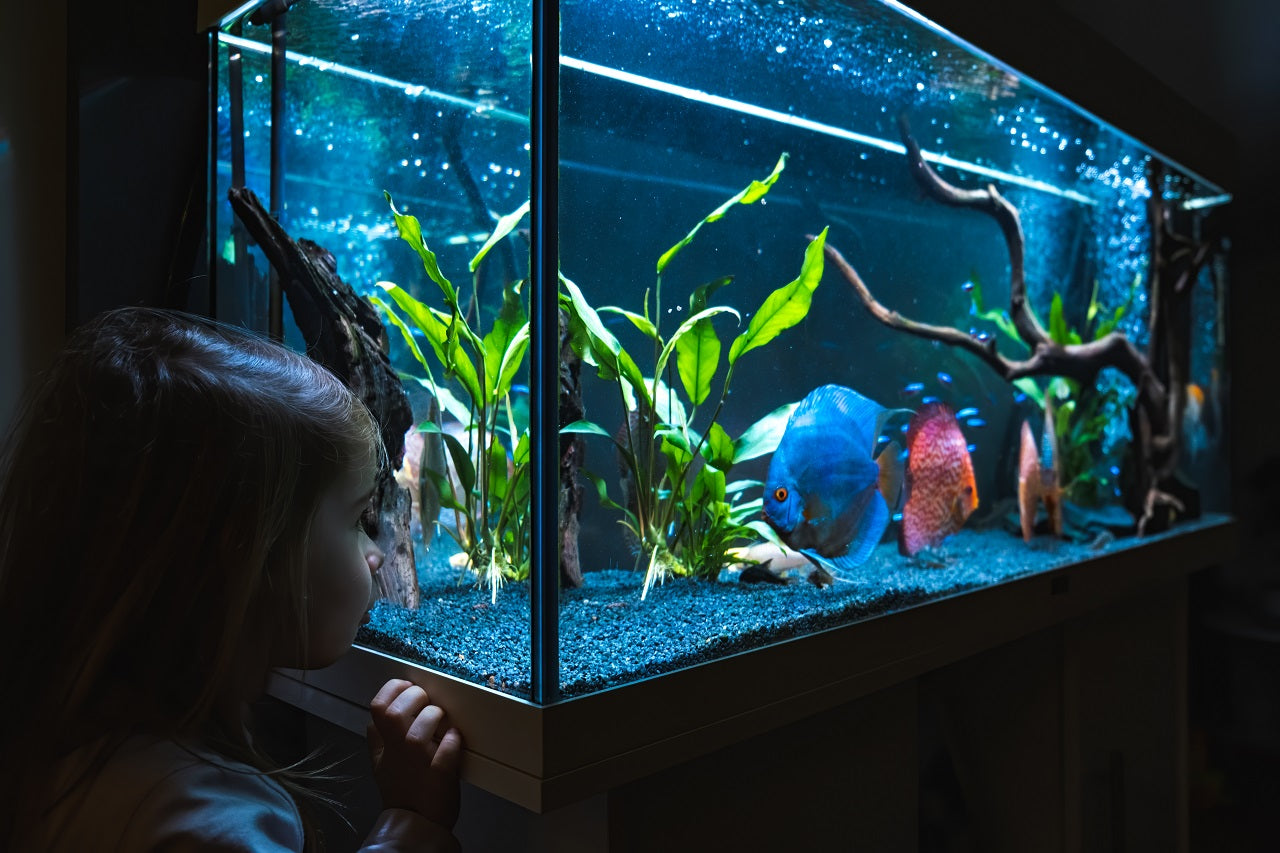Table of Contents
Creating a verdant, thriving aquatic garden is a dream for many aquarium enthusiasts. The numerous factors influencing plant growth, such as CO2, nutrient levels, and water parameters, can be a complex endeavor. However, one of the most critical yet often overlooked components of a successfully planted aquarium is lighting. A deeper understanding of the nuances of planted aquarium lighting, from the light spectrum and intensity to photoperiod and fixture selection, can unlock a world of lush aquatic plant growth and vibrant, healthy underwater ecosystems.
In this guide, we will explore light's pivotal role in maintaining an eye-catching aquatic garden. We'll delve into the science behind aquatic plant growth and break down the key elements of aquarium lighting, such as the light spectrum's importance, intensity, and duration's role, and how to choose the perfect lighting fixtures for your specific aquarium setup. With our complete lighting guide at your side, you'll be well-equipped to create a lush, captivating underwater paradise where your live aquatic plants flourish and your aquarium inhabitants, including freshwater fish, freshwater shrimps, and other invertebrates, revel in their verdant surroundings.
Whether you're a seasoned aquarist or a newcomer seeking to hone your expertise in planted aquariums, our extensive lighting guide will serve as an invaluable resource for untangling the complexities of light and its profound impact on your underwater world. Equipped with this newfound knowledge, you'll be well on your way to cultivating a breathtaking, flourishing aquatic garden where both aquatic plants and fish can thrive in harmony.
1. The Science of Aquatic Plant Growth: Demystifying Photosynthesis
Before diving into the intricacies of aquarium lighting, it's critical to understand the process of photosynthesis, as it plays a vital role in aquatic plant growth:
Photosynthesis Basics
Plants, including aquatic species, transform light energy into essential nutrients and oxygen through a process called photosynthesis. In the presence of light, water, and carbon dioxide (CO2), plants produce glucose and oxygen, supporting growth and releasing life-sustaining oxygen into the water column.
Light Spectrum and Plant Pigments
Different wavelengths of light, known as the light spectrum, play a crucial role in photosynthesis. Chlorophyll, the pigment responsible for capturing light energy in plants, absorbs primarily red and blue wavelengths, making these colors fundamental to plant growth.
2. Key Elements of Planted Aquarium Lighting: Spectrum, Intensity, and Photoperiod
With a foundational understanding of photosynthesis, we can now focus on the key elements of lighting a planted aquarium:
Light Spectrum
To maximize the effectiveness of your lighting system, aim for a full-spectrum light setup that includes both red and blue wavelengths for optimal plant growth. Full-spectrum lighting provides a balanced and natural appearance and mimics sunlight for improved photosynthesis and plant health.
Light Intensity
Light intensity, measured in lumens or PAR (Photosynthetically Active Radiation), is crucial for promoting plant growth. Different freshwater plants have varying light intensity requirements, with some thriving in low light and others demanding high light levels. Consider your aquarium's plant composition and choose a lighting system with adjustable intensity to accommodate your plants' specific needs.
Photoperiod
The photoperiod, or duration of daily light exposure, influences both plant growth and aquarium inhabitants' well-being. Aim for a consistent daily photoperiod between 8-10 hours to provide ample light for photosynthesis, while preventing excessive algae growth.
3. Choosing the Right Lighting Fixtures: Options for Every Setup
Several types of lighting fixtures are available to suit varying planted aquarium setups, each with unique features and benefits:
Fluorescent Lighting
Traditional fluorescent lights, especially T5 and T8 fixtures, are a popular and cost-effective option for planted aquariums. Full-spectrum fluorescent bulbs can provide sufficient light for low—to medium-demanding plants.
LED Lighting
LED lighting systems have gained popularity due to their energy efficiency, customizable spectrums, and slim design. Some LED fixtures offer advanced features, such as automated sunrise and sunset settings, creating a more natural lighting transition for aquarium inhabitants.
Metal Halide and High-Output (HO) Lighting
Metal halide and high-output lighting fixtures can deliver intense light, making them well-suited for deeper tanks or aquariums with plants that demand a lot of light. However, these systems often produce more heat, requiring additional cooling measures such as fans or chillers.
4. Essential Tips for Maintaining Optimal Lighting Conditions
To ensure your aquarium lights remain effective over time, follow these essential maintenance tips:
Regular Bulb Replacement
Over time, light bulb output may decrease, resulting in reduced photosynthesis. To maintain optimal lighting conditions, replace fluorescent bulbs every 6-12 months and monitor LED fixtures for any decline in performance.
Fixture Cleaning and Maintenance
Regularly clean your lighting fixtures, removing any dirt or algae that may reduce light output. Keep glass covers and aquarium lids clean to ensure maximum light penetration in your planted aquarium.
Monitoring Algae Growth
Excessive algae growth can indicate imbalances in lighting conditions, such as overly intense light, an extended photoperiod, or inadequate water quality. Address these issues promptly to maintain a healthy and vibrant aquatic garden.
Illuminate Your Planted Aquarium to Cultivate a Lush, Vibrant Aquatic Garden
An optimally-lit planted aquarium lies at the intersection of art and science, fostering a dynamic, thriving aquatic environment where both plants and aquarium fish can flourish. By understanding the science of photosynthesis, mastering the nuances of the light spectrum, intensity, and duration, and selecting the right fixtures for your specific setup, you'll create a captivating underwater oasis that radiates with life and color.
Embark on your planted aquarium journey with confidence and trust in Splashy Fish tropical fish store as your go-to source for the highest quality aquarium fish for sale, invertebrates, live aquarium plants for sale, and aquarium supplies, ensuring that your aquatic adventure is rewarding, educational, and inspiring.



























